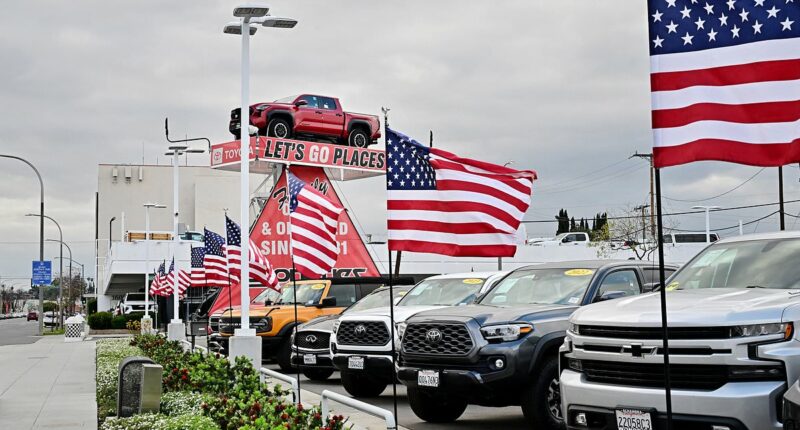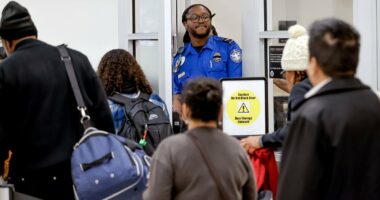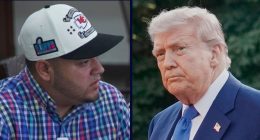Share this @internewscast.com
The United States is experiencing an alarming rise in car repossessions as more Americans find themselves unable to keep up with auto loan payments.
Research from the Recovery Database Network (RDN), featured by CURepossession, reveals that projections for 2025 could see more than 3 million vehicles repossessed. This marks the highest level since the economic downturn during the financial crisis.
In just the last quarter of this year, it is estimated that 820,236 vehicles will be repossessed nationwide.
Even more Americans are at risk of joining these numbers as they struggle with their financial obligations.
According to Fitch Ratings, the situation is particularly dire among subprime borrowers—individuals with poor or no credit. As of August, 6.43 percent of these borrowers were at least 60 days overdue on their loans.
The percentage of subprime borrowers – those with poor or no credit – who are at least 60 days late on their loans was at 6.43 percent in August, according to Fitch Ratings.
This figure has doubled since 2021, and is worse than during the dot-com recession, the Covid-19 pandemic and the financial crisis.
Economists are warning that this consumer weakness could be a warning sign about serious cracks in the US economy which could lead to financial meltdown.

Car repossessions are surging across the US, as an increasing number of Americans fall behind on their auto loans
Car loans tend to be the final payments that Americans are willing to miss, after credit card or mortgage payments.
This is because cars are so essential for their daily lives. They need them to get to work, to take their children to school, or to access groceries.
The average cost of a new car in the US has now eclipsed $50,000 for the first time in history.
This, coupled with high interest rates, has sent auto loan payments soaring and piled increasing pressure on car owners.
Drivers owe $1.66 trillion in car loans – a bigger burden than federal student loan debt or credit cards – which is up 20 percent since 2020.
The average monthly payment for a new car is now $749, and $529 for a used car.
Car insurance rates have also surged in recent years, as well as costs for repairs.
Even Ford, one of the largest car companies in the US, has started offering subprime loans revive sluggish F-150 sales. Last month, it began offering low-interest loans to Americans with credit scores under 620.

Economists are warning that this consumer weakness could be a warning sign about serious cracks in the US economy
Ford, America’s most iconic car company, has even started offering car loans to buyers with lower credit scores (Pictured: Actress Sydney Sweeney with her 1969 Ford Bronco)
The default rate for subprime borrowers was around 10 percent in September, according to data from Cox Automotive.
Many are left with little choice but to default, as they cannot sell their car as their loan is worth more than the vehicle. They also tend to have other loans, such as mortgages or student debts, to contend with.
This weakness in the auto market is a clear indication that low and middle-income families, who are seen as the foundation of the economy, are under increasing financial pressure.
This is in contrast to the booming stock market, which continues to climb.
Kevin Armstrong, author of Repo Blood: A Century of Auto Repossession History, told the Guardian that auto loan delinquencies are ‘one of the canaries in the coalmine’ for the broader health of the economy.
He traced the rise in repossessions to the pandemic, when stimulus checks and extra unemployment aid meant that consumers were able to pay for more expensive cars, which they can now no longer afford.
‘When Covid hit, prices went through the roof,’ he told the outlet.
‘I watched people paying outrageous amounts for cars that just weren’t going to hold their value, and the dealers laughing all the way to the bank. They got hosed.’
Recent bankruptcies have also triggered alarm bells in the auto industry, with some experts suggesting that they could herald a 2008-style crash.

Subprime auto lender Tricolor went bankrupt last month, in a major warning sign for the health of the US economy

Chase CEO Jamie Dimon warned about ‘cockroaches’ in the economy after two auto companies went bankrupt
Last month, subprime auto lender and dealer Tricolor went bust.
Not long after, auto-parts supplier First Brands also filed for bankruptcy amid an accounting scandal that has left lenders scrambling for more than $2 billion in missing funds.
Borrowers at the lower end of the income spectrum tend to default first, and there are growing fears that other lenders targeting the same group could also collapse – echoing what happened with subprime home loans in 2008.
‘My antenna goes up when things like that happen,’ JPMorgan Chase CEO Jamie Dimon said on an analyst call following the bankruptcies.
‘And I probably shouldn’t say this, but when you see one cockroach, there are probably more… Everyone should be forewarned on this.’
















